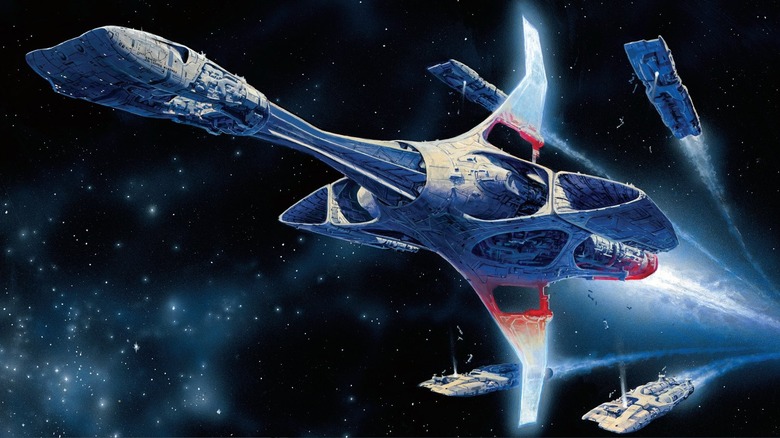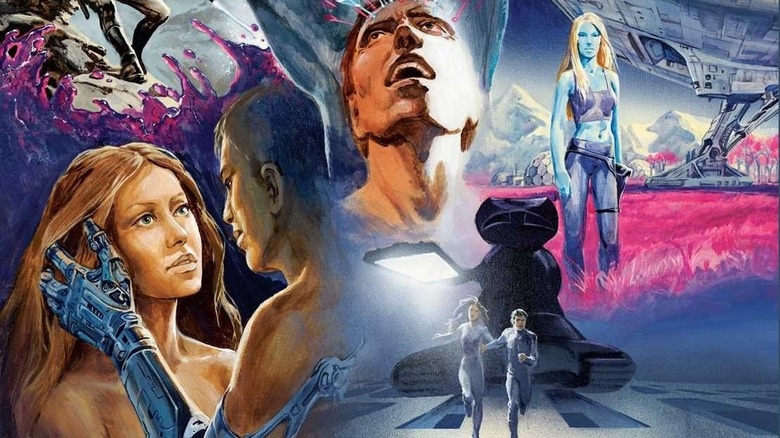James Cameron Talks His Scrapped Xenogenesis Script And How It Saved Avatar [Exclusive]
We may receive a commission on purchases made from links.
Before "Titanic" and "Avatar" director James Cameron was King of the World, he was an upstart young filmmaker trying to get his first feature off the ground. Created in the wake of the "Star Wars" phenomenon, Cameron and his pal Randall Frakes set out to make an extremely ambitious science-fiction movie titled "Xenogenesis" about a young woman and an artificial man sent on a mission to scour the galaxy for a planet suitable for creating new life. With $20,000 raised from a local dentist, the two set about creating a short 12-minute pitch movie featuring some of Cameron's detailed concept paintings as well as a live-action sequence shot in ad-hoc sets built in his living room along with some cool stop-motion.
The resulting "Xenogenesis" short is one of the most impressive first films you may have ever seen, especially given that it was made in 1978 when most of the techniques used were not commonplace in the indie realm. We recently had the good fortune to chat with James Cameron as he promotes his new book "Tech Noir: The Art of James Cameron" from Insight Editions. The 300-plus page volume is jam-packed with the "Terminator" director's early artwork, a good deal of which is from the scrapped "Xenogenesis" feature project, which we got to ask him about.
The Original Xenogenesis Short
As you can see, the original "Xenogenesis" pilot, if you will, is a scrappy but quite impressive work of sci-fi imagination not unlike George Lucas' 1967 student film "Electronic Labyrinth: THX 1138 4EB." It lays out the gist of the story of what the film follows, then lays you right in the middle of the story as the main characters Raj (future "Terminator 2: Judgment Day" co-writer William Wisher Jr.) and Laurie (Margaret Umbel) battle a robot in a futuristic station.
The first thing you might notice is how many of Cameron's future works are predicted by the short, including the robotic arm and giant hunter-killer tanks of "The Terminator," the image of a blue woman later realized for "Avatar," and of course the female-operated mech coming to save the day à la "Aliens." Even the textures of the sets are similar to those Cameron would later design for Roger Corman's cheapie "Alien" rip-off "Galaxy of Terror."
With that in mind, we asked Cameron if he still has a little more meat to pick off the bones of "Xenogenesis" for future projects. Here's what he told us:
"Well, I'm like the Native American tribe that kills the bison and use[s] every part of it. I think there might be still some stuff back there in 'Xenogenesis,' I should probably go reread it, you know? It was obviously just an excuse to jam in all the cool ideas that my friend Randy and I could think of when we were writing it. The very fact that we were having to create a narrative that tried to connect the dots of all these cool ideas is the flaw of the script. I did reread it recently. It's not bad, but it's kind of all over the map. I could have taken any one of 10 ideas in that and add it up into a feature story."
'Dude, You Gotta Just Go to Hell'
Other elements of "Xenogenesis" were eventually cannibalized for the $300 million budgeted "Avatar," including the soaring banshees and fan-like flying lizards. Luckily for Cameron, he held onto all of this original art not only so we can now see the early seeds of these movies, but also because they came in handy for cash-grab nuisance lawsuits. Here's what Cameron told us about this:
"No, I think I'm done picking the bones of it, but I think you can see that the some of the artwork that I did for 'Xenogenesis' of the bioluminescent world actually saved us tens-of-millions of dollars on 'Avatar,' because we got sued by everybody and their dog. I could point back to stuff I did in 1977 before some of these people that were suing me were born and say, 'No we've got prior art, dude, you gotta just go to hell.' And they did, basically. We had 11 lawsuits that were what they called summary judgments, they were just kicked to the curb, and it was a lot of that early artwork that turned the tide. So be warned, if you're going to write a big hit movie or direct a big hit movie, keep track of all that early stuff because otherwise people love to just step up and say, 'Hey, that was my idea. I kept the tinfoil on my head, but their laser saw through it.'"
If you have the chance definitely pick up a copy of "Tech Noir" in stores now, as it is an invaluable document of the seminal work of one of cinema's great sci-fi visionaries. It also includes early childhood artwork, along with some of his lesser-seen poster art for some early-80's direct-to-video sleaze before he established himself as a director. You also get to see his designs for movies like the first two "Terminator" films, "Aliens," "Titanic" (he drew all of Jack's art personally) up to the first "Avatar."

